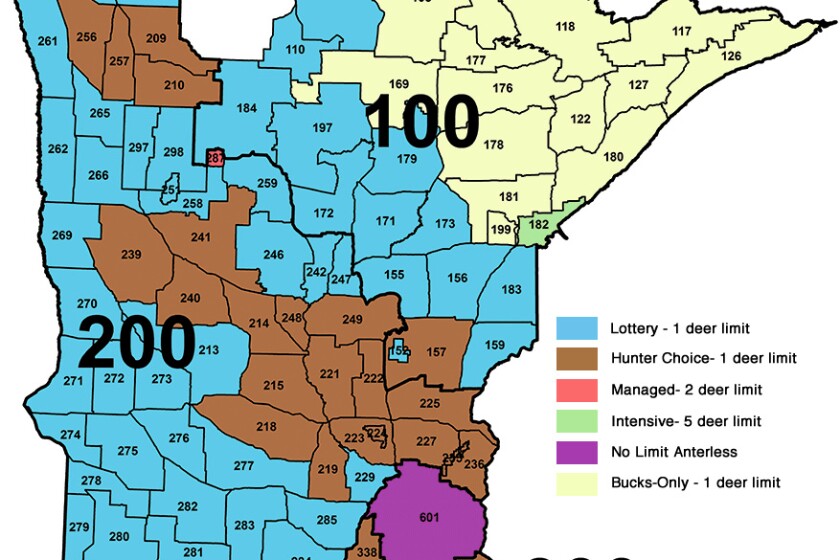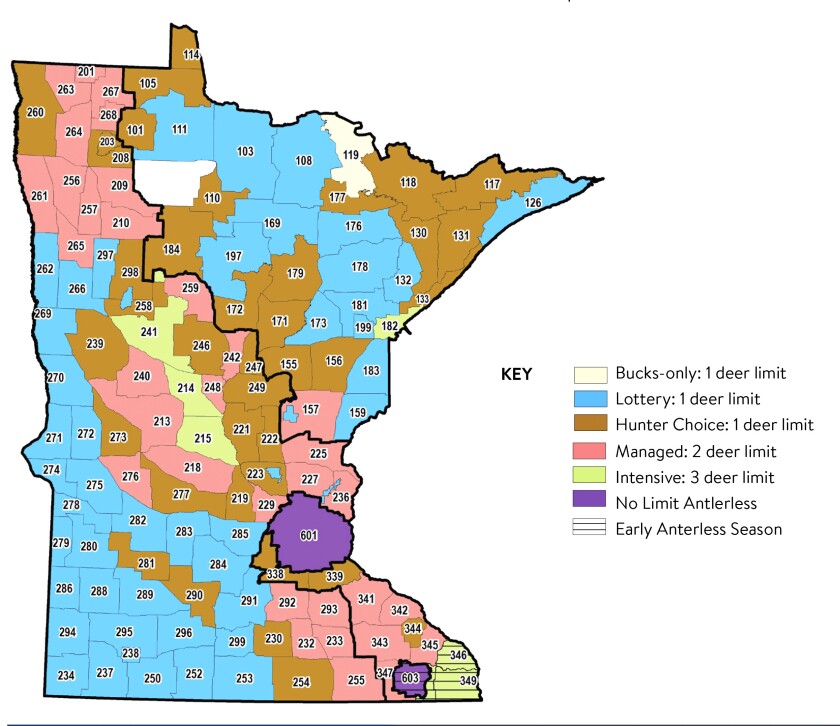Minnesota Dnr Deer Hunting: Essential Tips for a Successful Season
Deer hunting in Minnesota is a cherished tradition. The Minnesota DNR ensures this practice is safe and sustainable.
Minnesota’s Department of Natural Resources (DNR) plays a crucial role in managing the state’s deer hunting activities. From setting hunting seasons to providing guidelines, the DNR works tirelessly to maintain a balance between wildlife conservation and recreational hunting. Deer hunting not only supports wildlife management but also brings communities together.
Hunters eagerly await the season, preparing their gear and planning trips. Whether you are a seasoned hunter or a newcomer, understanding the DNR’s rules and recommendations is vital. This ensures a successful and responsible hunting experience. Join us as we delve into the essentials of Minnesota DNR deer hunting, where tradition meets careful stewardship.

Credit: www.echopress.com
Season Preparation
Preparing for the deer hunting season in Minnesota is crucial for success. Proper preparation helps ensure safety, legality, and a rewarding experience. This section will cover the essential steps to get ready for the hunt.
Permits And Regulations
First, check the Minnesota DNR website for the latest hunting regulations. These rules can change yearly, so stay updated. Apply for the necessary permits well in advance. Some areas have limited permits, so early application increases your chances. Always carry your hunting license with you during the hunt. Understand the bag limits and legal hunting hours to avoid fines. Follow all safety rules, including wearing blaze orange clothing.
Gear And Equipment
Having the right gear is key to a successful hunt. Start with a reliable rifle or bow, depending on your preference. Ensure your weapon is clean and in good working condition. Invest in quality optics, like scopes or binoculars, for better visibility. Wear appropriate clothing for the season. Layered clothing works best for changing weather. Do not forget sturdy boots for long walks. Pack a hunting backpack with essentials like water, snacks, and a first aid kit. Include a field dressing kit for processing your game. Use scent control products to avoid detection by deer. Lastly, practice with your gear to ensure you are comfortable and accurate.
Scouting Locations
Scouting locations is a vital step in Minnesota DNR deer hunting. The right location can make all the difference. By understanding the best hunting areas and the differences between public and private land, hunters increase their chances of a successful season.
Best Hunting Areas
Minnesota offers diverse habitats ideal for deer hunting. The northern forests provide dense cover. Deer find shelter and food there. The transition areas between forests and fields are also prime locations. Deer often travel through these zones. These areas offer clear shots for hunters.
Southern Minnesota has rich farmlands. Deer graze on crops and find plenty of food. Look for signs like trails and tracks. These indicate active areas. The bluff country in southeastern Minnesota is another hotspot. Its rugged terrain supports a healthy deer population.
Public Vs Private Land
Public land is accessible to all hunters. It includes state forests, wildlife management areas, and national forests. These areas offer large tracts of land. Scouting is crucial because many hunters use these lands. Look for less-traveled spots to avoid crowds.
Private land offers exclusive access. Hunters must get permission from landowners. This can mean less competition. Private lands can be more managed. They might have food plots or specific hunting regulations. Building a good relationship with landowners is key. Respect their property and follow the rules.
Understanding Deer Behavior
Understanding deer behavior is crucial for a successful hunting experience in Minnesota. By knowing how deer act throughout the year, hunters can improve their strategies and increase their chances of success. Let’s dive into the key aspects of deer behavior: seasonal patterns and feeding habits.
Seasonal Patterns
Deer behavior changes with the seasons. In the spring and summer, deer are more active during the day. They spend most of their time feeding and resting. As fall approaches, their behavior shifts.
During the fall, deer enter the rutting season. This is the mating period, and bucks become more aggressive. They are more likely to roam, making them easier to spot but harder to predict. In winter, deer conserve energy. They move less and seek shelter from the cold. Understanding these patterns helps hunters know when and where to find deer.
Feeding Habits
Deer feeding habits also vary by season. In the spring, they prefer fresh grasses and plants. Summer diets include leaves, fruits, and crops. Fall is a time for acorns and nuts, which are high in energy.
In winter, food is scarce. Deer often rely on woody plants and leftover crops. They feed more at dawn and dusk, known as crepuscular feeding. Hunters can use this knowledge to set up near feeding areas at the right times.
Understanding these feeding habits can help hunters choose the best locations for their stands. They can also select the right times to hunt, increasing their chances of a successful season.
Safety Measures
Safety is a top priority for deer hunting in Minnesota. Following safety measures helps prevent accidents and ensures a successful hunt. Here are some crucial safety tips to keep in mind.
Proper Firearm Handling
Handling a firearm requires attention and care. Always treat your firearm as if it’s loaded. Never point it at anything you don’t intend to shoot. Keep your finger off the trigger until ready to fire. Ensure the barrel is clear of obstructions before loading. Check your surroundings and identify your target clearly before shooting.
Hunting With A Partner
Hunting with a partner increases safety and enhances the experience. Always stay within sight or communication range of each other. Use agreed-upon signals for communication. Ensure both partners know the location and movements of each other. In case of an emergency, having a partner can be a lifesaver.
Hunting Techniques
Deer hunting in Minnesota offers an exciting and rewarding experience. Understanding different hunting techniques can improve your chances of success. Two popular techniques are stand hunting and still hunting. Each method has its unique approach and benefits.
Stand Hunting
Stand hunting involves staying in one spot, usually elevated, waiting for deer to come by. This method is effective because it minimizes movement and noise.
Key points for stand hunting:
- Choose a location with good visibility and cover.
- Set up early, before dawn or dusk.
- Use scent blockers to reduce human scent.
- Bring necessary gear: rifle, binoculars, and snacks.
Patience is critical in stand hunting. Staying alert and quiet increases your chances of spotting a deer.
Still Hunting
Still hunting requires slowly moving through the woods, looking for deer. This method demands keen observation and stealth.
Steps for successful still hunting:
- Move slowly and quietly through the forest.
- Stop frequently to listen and observe.
- Wear camouflage to blend with the surroundings.
- Use natural cover like trees and bushes.
Still hunting allows you to cover more ground and find deer in different areas. It requires practice but can be very rewarding.
Choosing the right technique depends on personal preference and hunting conditions. Both stand hunting and still hunting can yield great results.
Field Dressing And Processing
Field dressing and processing your deer correctly is essential to ensure the quality of the meat and to comply with regulations. Here we will guide you through the process step by step, starting with the essential tools you will need.
Essential Tools
- Sharp knife
- Gloves
- Cord or rope
- Cooler with ice
Step-by-step Guide
- Secure the deer by tying its legs together.
- Make an incision from the breastbone to the pelvic bone.
- Remove the internal organs carefully.
- Cut around the anus to free the rectum.
- Cool the carcass promptly and thoroughly.
Weather Considerations
Weather plays a crucial role in Minnesota DNR deer hunting. Hunters must consider various weather conditions to maximize their success. Different weather patterns can significantly influence deer behavior and hunters’ comfort.
Impact On Deer Movement
Deer are more active during cooler temperatures. They tend to move less during hot weather. Rain can also affect their movement. Light rain might increase activity, but heavy rain can decrease it. Snow can make tracking easier. It also highlights deer trails. Wind direction is another factor. Deer move into the wind to catch scents of predators.
Dressing For The Weather
Proper clothing is vital for successful hunting. Layering helps regulate body temperature. Choose moisture-wicking base layers. Insulating layers keep you warm. Outer layers should be waterproof and windproof. Boots should be insulated and waterproof. Gloves and hats are essential. They help retain body heat. Always carry extra clothing in your pack. Weather can change quickly.

Credit: www.echopress.com
Ethical Hunting Practices
Hunting is a cherished tradition in Minnesota. It brings families together and helps manage wildlife populations. Practicing ethical hunting is crucial. It ensures the health of deer herds and respects the environment. Here are some key ethical hunting practices.
Respecting Wildlife
Respecting wildlife is fundamental. Hunters must always aim for a quick, clean kill. This minimizes the animal’s suffering. Using the right equipment is essential. Choose appropriate firearms or bows. Ensure they are well-maintained and accurate.
Never take more than you need. Follow bag limits and regulations set by the Minnesota DNR. Avoid shooting at animals that are too far away. This reduces the risk of wounding and losing the deer. Always track and recover wounded animals.
Sustainable Hunting
Sustainable hunting helps maintain deer populations. It ensures that future generations can enjoy hunting. Follow the Minnesota DNR guidelines and seasonal restrictions. Only hunt during the designated seasons.
Participate in conservation efforts. Support habitat restoration and protection programs. Join local hunting clubs and organizations. They often work on conservation projects. Educate others about the importance of sustainable hunting practices.
Consider the impact on the ecosystem. Avoid overhunting in one area. Rotate your hunting spots. This helps maintain a balanced deer population. Use non-lead ammunition to protect other wildlife from lead poisoning.

Credit: www.dnr.state.mn.us
Frequently Asked Questions
When Does Deer Hunting Season Start In Minnesota?
Deer hunting season in Minnesota typically starts in early November. It varies slightly each year.
What Types Of Deer Are In Minnesota?
Minnesota is home to white-tailed deer. They are the most common species for hunting.
How To Get A Deer Hunting License?
You can get a deer hunting license through the Minnesota DNR website or authorized vendors.
What Are The Rules For Deer Hunting In Minnesota?
Deer hunting rules in Minnesota include specific regulations on hunting zones, weapon types, and bag limits.
Conclusion
Minnesota DNR deer hunting offers unforgettable experiences for all hunters. The state’s rich wildlife and beautiful landscapes enhance the adventure. Remember to follow regulations and practice safe hunting. Respect nature and contribute to conservation efforts. These practices ensure future generations can enjoy this tradition.
Plan your next hunt in Minnesota and create lasting memories. Happy hunting!





